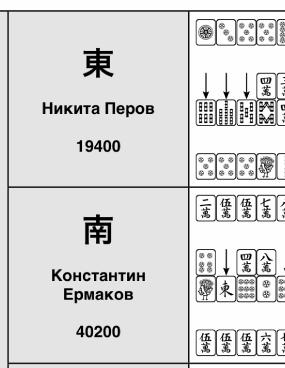How to Read Paifu
Paifu is a written record of the game. In reach mahjong paifu is usually used for pro games, while amateurs prefer to watch replays. Replays of course are easier to understand, but paifu also has its own advantages:
- Paifu shows the starting and the final hand at the same time, along with discards and changes made in the hand. It allows to trace the development of the specific hand.
- Paifu of one round easily fits on a standart A4 sheet, you don't need a computer to watch it. You can take printed paifu with you and read them on the road.
So, how do we read paifu? There are two ways. The first one is to read horizontally, paying attention to each player separately:

On the left we can see the position of the player, their name and the amount of points. The right part is divided fourfold:
- the first line: starting hand,
- the last line: final hand,
- the second line is tsumo,
- the third — discard.
If the player made tsumo-kiri, the tile is only showed in the discard, and in the second line an arrow down is drawn. If the player opened a set from their hand, above the tile which was taken there is a mark チー (chi) or ポン (pon). If the player has won, the winning tile is drawn on the right of his hand with «ron» or «tsumo» remark. In case of a riichi the tile, on which it was declared, is marked with リーチ. Finally, the missing turn (in case of another player making an open set) is showed with a space.
The second way is to read a paifu upright. In this case we analyze the sequence of players' actions.
 If you read this way, you may ignore the starting and the final hand. You should also remember that the dealer always stands first in paifu. His first move is in the left column. Then in the same column paifu shows the first move of a south player (if there were no sets opened). One column is one turn — four tsumos and discards (one for each player). Arrows up for tsumo-kiri help us, reminding about the right way to read paifu.
If you read this way, you may ignore the starting and the final hand. You should also remember that the dealer always stands first in paifu. His first move is in the left column. Then in the same column paifu shows the first move of a south player (if there were no sets opened). One column is one turn — four tsumos and discards (one for each player). Arrows up for tsumo-kiri help us, reminding about the right way to read paifu.
Exercise: try to recreate the flow of a round using a paifu of JPMA:
